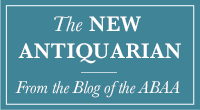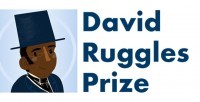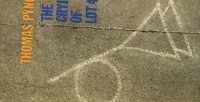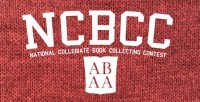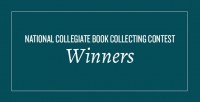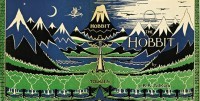The Antiquarian Booksellers' Association of America is proud to announce sponsorship of the David Ruggles Prize. The David Ruggles Prize is an international book-collecting prize to encourage and support young collectors of color. The Prize honors the legacy of David Ruggles, an early American abolitionist, publisher, and Underground Railroad conductor. The New York grocery store he opened in 1828 soon became the country's first Black-owned bookstore. Beyond rewarding existing collectors, this Prize hopes to encourage young book lovers to become book collectors. The Prize awards three applicants annually whose collections are considered most outstanding by a panel of judges. Grand Prize: $1,000 Second Prize: $500 Third Prize: $250 Entry is open to anyone aged 35 and under, anywhere in the world. This year's deadline to enter is June 9, 2024. Whether it is comic books and graphic novels, zines, contemporary book art, or handwritten manuscripts—all are welcome to apply. Want more information? Click here to learn more about the Prize and past winners and meet the judging panel. Find the David Ruggles Prize on Instagram, Threads, and Twitter/X @rugglesprize. Submit your application today! [more David Ruggles Prize]
On Collecting Books
Our members list new acquisitions and recently cataloged items almost every day of the year. Below, you'll find a few highlights from these recent additions... (Trade catalog): Your Typewriter. Shipman-Ward Mfg. Co. "The Rebuilders of the Underwood" Chicago: Shipman-Ward Mfg. Co, 1926. Softcover. Fine. Trade catalog. Quarto. Unpaginated. Illustrated. Order form and promotional letter laid in. Stapled illustrated wrappers. A touch of rubbing on the wrappers, about fine. Elaborate and nicely illustrated catalog of a company whose entire business was repairing Underwood Typewriters. Offered by Between the Covers Rare Books. Map of Love by Dylan Thomas 1939. First Edition . Signed. THOMAS, Dylan. The Map of Love. Verse and Prose. London: J. M. Dent and Sons, (1939). Octavo, original purple cloth, original dust jacket; housed in a custom slipcase. First edition in book form, twice inscribed by Thomas, once beneath the frontispiece portrait by Augustus John: “As I was, or might have been, to Norman Unger from ,” and a second time on the front free endpaper: “ Norman Unger. Dylan Thomas 1950.” Among the works included in this collection of poems and lyrical prose, which had all appeared in periodicals and which here make up Thomas's third book, are ""When all my Five and Country Senses see,"" ""After the Funeral,"" ""Not from this Anger,"" and ""The Mouse and the Woman."" First issue, in fine-grained purple cloth with ""Dent"" blind-stamped on spine. Maud, 5. Norman Unger, t... [more Weekly Highlights]
The ABAA is accepting entries for the 2024 National Collegiate Book Collecting Contest where more than $6,000 in prizes will be awarded to student collectors! The National Collegiate Book Collecting Contest is jointly administered by the Antiquarian Booksellers' Association of America (ABAA), the Fellowship of American Bibliophilic Societies (FABS), the Grolier Club, and the Center for the Book and the Rare Books and Special Collections Division of the Library of Congress. The contest is open to all prizewinners of college contests, whether or not first prize, and to interested students whose institutions do not offer contests. More information can be found here... All entries should be submitted here (in PDF) by June 10, 2024. For more information on the contest, please visit contest.abaa.org... 2023 NCBCC winners... [more 2024 National Collegiate Book Collecting Contest]
The ABAA and Sanford L. Smith & Associates are proud to announce that the British Library will be the institutional partner for ABAA Connect at this year's New York International Antiquarian Book Fair. A program resurrected from the early 2000's, ABAA Connect will allow our 2024 institutional partner, the British Library, to request items at the NYIABF from exhibitors, and have those items purchased for the Library as recommended by tax-advantaged contributions from donors to the American Trust for the British Library (ATBL). British Library curators will browse a list of items exhibitors will bring to the fair and choose items they are interested in acquiring. Our British Library and ATBL colleagues and donors will attend the fair and discover these items together in person, and donors can either contribute the value of an item in its entirety or make a gift in part to the acquisition value for a particular item. Unique to the 2024 ABAA Connect program: the ATBL will guarantee the acquisitions requested by British Library curators. The NYIABF hopes this program will expose curators to exciting items, connect booksellers with the British Library and their curators, entice donors to attend the fair and purchase items that will benefit both the British Library and their personal collections, and inspire any fairgoer to become a donor. Location Park Avenue Armory 643 Park Avenue, New York, NY 10065 www.armoryonpark.org Preview: $75 (Includes one daily re-admission) Single-Day A... [more ABAA & British Library Bring ABAA Connect to New York Book Fair in April]
The Celluloid Paper Trail: Film Script Identification Course at UCLA August 5-9 2024 Kevin Royal Johnson and Erin McGuirl will teach the first west coast Master Class on film script identification from August 5-9, 2024 at UCLA's California Rare Book School (CalRBS). Kevin Johnson has been a rare bookseller and appraiser for nearly 30 years. He is the author of the first book on film script identification, The Celluloid Paper Trail, published in 2019 by Oak Knoll Press and is the owner of Royal Books in Baltimore. Erin McGuirl/has been the Executive Director of the Bibliographical Society of America since 2018. She is trained as a special collections librarian, and has worked for over a decade with institutional and private collections in New York City. Course overview: What kind of text is a screenplay? How were they made, and by whom? How did their form and function change over time? In hands-on exercises with archival film scripts and through course lectures, students will explore these questions by learning about the history, development, and bibliographical identification/of the American film script, from the silent era to the end of the twentieth century./ Screenplays are guides to the creation of another work of art: a motion picture. Students enrolled in/The Celluloid Paper Trail/will learn to see scripts as “blueprints” for films and to identify the material cues that tell how they fit into the larger filmmaking process, revealing the contributions of both credite... [more The Celluloid Paper Trail: Film Script Identification Course at Cal-RBS Aug 5-9]
Library of Congress Names Stephanie Stillo Chief of Rare Book and Special Collections
By Susan BenneThe Library of Congress named Stephanie Stillo the new chief of the Library's Rare Book and Special Collections Division. Stillo joined the Library in 2016 and previously served as the curator of the Lessing J. Rosenwald Collection and the Aramont Library — two of the division's notable collections. The Rare Book and Special Collections Division is North America's largest collection of rare books. Spanning eras and subjects, its holdings include nearly 1 million books, broadsides, pamphlets, theater playbills, title pages, prints, posters, photographs, and medieval and Renaissance manuscripts. President Thomas Jefferson's library is at the center of the collection, which was sold to Congress in 1815. As division chief, Stillo will lead the collection's development, stewardship, interpretation, promotion, and service to meet the needs of government officials, scholars and the public. During her time at the Library, Stillo has collaborated with division staff to launch several engagement initiatives — including the division's first crowdsourcing campaign and two large symposiums — as well as the Artists and Archives program, which manages an archivist every year to process archival arrearage relating to the contemporary book arts. She also oversees the division's popular video series “From the Vaults” and co-manages the division's blog, Bibliomania. “Over the past seven years as Curator of the Lessing J. Rosenwald Collection and the Aramont Library, I have had the p... [more Library of Congress Names Stephanie Stillo Chief of Rare Book and Special Collections]
Rare book donations are being sought for an auction to help "turn the page" on Russian aggression in Ukraine. Helping Ukrainian Books and Booksellers (HUBB for short) is preparing an international rare book sale to support colleagues under fire in Ukraine. They have scheduled an online auction for mid-November and are actively seeking donations of rare and collectible books, manuscripts, artwork, and ephemera. HUBB was founded by Mitchell Kaplan, Jane Unrue of Scholars at Risk, Carolyn Forche, Christopher Merrill, and Askold Melnyczuk shortly after the start of the war. The group has contacted Oleksandr Afonin, president of the Ukrainian Publishers and Booksellers Association (UBPA) to offer assistance. So far, they've raised over $30,000. HUBB recently distributed $10,000 among some 60 publishers and booksellers across Ukraine. Afonin says that these modest grants have made a big impact on individuals whose lives have been disrupted by the war. In the second round, Ukrainian libraries were invited to apply for grants to fund new books. Melnyczuk reports that HUBB has been able to fund 30 out of the nearly 1,000 applications. "Right now, we're asking supporters to aid our effort by donating a rare or collectible book, manuscript, photograph, artwork, or item of ephemera from their personal collection, which Catalog Sale will put up for online auction in mid-November," Melnyczuk says. "This is an immediate opportunity for booksellers, dealers, and collectors to directly aid th... [more Rare Book Donations Sought for Auction to Benefit Ukranian Booksellers]
The Antiquarian Booksellers' Association of America (ABAA) is delighted to announce the winners of the 2023 National Collegiate Book Collecting Contest: First Prize Ishaan Prasad (Harvard College) for "Confessions of a Former Sheep Thief: Ten Years of Exploration in Typography". Prasad first became interested in typography while designing arcade-style games for the iPhone, which led to a desire to understand the principles and reasoning behind typography and design. Second Prize Joshua Shelly (Duke University) for "Alte Bücher in Haifa: (Re)building a German Jewish Library in the 21st Century". Shelly came to collecting while working on a dissertation on German Zionist literature and became intrigued by the experiences of “a generation that continued to search for solace in the pages of German literature, even while its members packed their bags and set sail for far-off locales in search of refuge.” Third Prize Enrique Vazquez (Yale University) for "Tales of the Midwestern Northwoods". Minnesota native Vazquez grew up exploring the Boundary Water Canoe Area with family; his collection grew as a way to remain connected to the North Woods while being unable to visit. Essay Award Nichole Nomura (Stanford University) for "Classroom Editions of Twain's The Adventures of Huckleberry Finn". Nomura's collection explores the evolving discourses around the teaching of race, the value of prose written in the vernacular, and perceptions of educators' obligations to students through ... [more 2023 NCBCC Winners]
J & J Lubrano Music Antiquarians LLC, established in 1977 and long-time members of the Antiquarian Booksellers' Association of America, the Professional Autograph Dealers' Association, the Music Library Association, the American Musicological Society, &c., are internationally recognized dealers in rare printed and manuscript music, rare books on music, autograph letters of composers, and music-related iconography, 15th - 21st centuries. We pay special attention to the particular collecting interests of our clientele and over the last 46 years have helped to develop some of the most important antiquarian music collections, both institutional and private, in the U.S. and abroad. We aim to provide accurate and informed descriptions of material offered to best enable our customers to make the wisest decisions regarding their acquisitions. We operate from private premises in the township of Syosset, on the north shore of Long Island. The area is known for its attractive parks, pleasant villages, and proximity to the Long Island Sound, as well as very good schools, hospitals, and high-level healthcare. Syosset is approximately one hour by train from New York City. This is a full-time, on-site position, with compensation commensurate with qualifications and experience but in the range of $45,000-$60,000. Responsibilities - Create original cataloguing for rare music-related material utilizing an in-house music reference library of approximately 5,000 volumes together with online reso... [more J & J Lubrano Music Antiquarians LLC Seeks Cataloguer]
One thing that distinguishes the book collector from the casual reader is a preference for owning first editions. What is a First Edition? A first edition is the format a book took when it was first made available for sale. The ABAA glossary of book terms states: First Edition: “All of the copies printed from the first setting of type; can include multiple printings if all are from the same setting of type.” Collectors distinguish between a first edition (the first printing of a book) and a modern first edition (which more-or-less applies to books printed from 1900 on -- although, the exact definition is open to debate between dealers). What is a First Printing? The first printing is the first batch of books printed from this first setting of type. For a small press, this might be the only printing a book gets, so all copies are first edition, first printings. The ABAA glossary is a master of understatement when it says “Every printed book has a first edition, many never have later editions.” For others, there might be dozens of printings, especially if a book becomes wildly successful. (Witness the recent trend to keep popular young-adult novels -- Veronica Roth's Allegiant and John Green's Turtles All the Way Down, for two examples -- in hardcover for several years, rather than replace the hardcover with a paperback edition a year after first publication.) How Can You Tell if a Book is a First Edition? In general, books before 1900 did not indicate first or subseque... [more Identifying First Editions]

